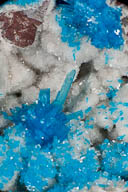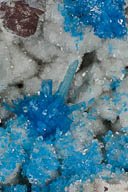Macro Stacking - Pentagonite
When taking macro or microscope photos with high magnification, the depth of field (the range of distances from the camera that are in focus) is very small. This works fine for flat subjects like postage stamps or coins, but is a problem for mineral specimens with crystals sticking out in all directions! I've been experimenting with a program that takes multiple images, each taken at a slightly different distance from the lens, to produce images with a larger depth of field than would be possible with a single exposure.
I've always had trouble photographing this particular specimen of Pentagonite with Calcite and Stillbite from Wagholi Quarry, Poona, Maharashtra, India, because it requires about 5 mm of depth of field over 15 mm of field size. There's no lens that can get that all in focus at the same time.
For this example, I took 7 frames and moved the camera back slightly between each shot. Here are two of the single frames to show what they look like without the processing.
Photo details for the geeky: 105 mm, f/2.8 macro lens (set at f/36) with 68 mm of extension tube. Seven shots with the camera moved .75 mm between. It was lit with 2 flashes from either side. CombineZP to align and automate the sharpest parts into the final and Lightroom to tweak sharpness, exposure and dust removal. (It's amazing how f/36 shows up the tiniest specs of dust on the camera sensor!) That long crystal in the center is about 4.5 mm long.


